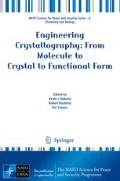Abstract
Crystal engineering approaches can be useful to understand, predict and design mechanical properties of the active pharmaceutical ingredients (APIs) for their improved performance in various stages of production. For example, the understanding of correlation among structure, mechanical property and powder compaction would allow prediction and design of powder tabletability of APIs. A design approach to achieve mechanically flexible plastic and elastic molecular crystals has recently been proposed. This involves the introduction of active slip planes (with minimal ruggedness) into the crystal structure by making different non-interfering weak interactions such as van der Waals (vdW), π-stacking and hydrogen bonding. By analyzing the reported crystal structures of plastically flexible crystals it can be hypothesized that the spherical hydrophobic groups will assemble via shape complementarity (shape synthons) to reliably form low energy slip planes. As these groups do not interfere with the π-stacking or hydrogen bonding groups, they can pack in a predictable manner and thus form slip planes to facilitate mechanical flexibility, as successfully demonstrated in a series of naphthalene diimide derivatives. Such studies can allow the preparation of exotic plastic crystals by design and through this demonstrate the potential for using soft interactions for tuning mechanical behaviour of ordered molecular materials. A comment is made on the prospects and ramifications of this emerging field, in the context of pharmaceutical solids.
Access this chapter
Tax calculation will be finalised at checkout
Purchases are for personal use only
References
Desiraju GR, Vittal JJ, Ramanan A (2011) Crystal engineering: a text book. World Scientific, Singapore
Desiraju GR (2013) Crystal engineering: from molecule to crystal. J Am Chem Soc 135:9952–9967
Reddy CM, Krishna GR, Ghosh S (2010) Mechanical properties of molecular crystals—applications to crystal engineering. CrystEngComm 12:2296–2314
Varughese S, Kiran MSRN, Ramamurty U, Desiraju GR (2013) Nanoindentation in crystal engineering: quantifying mechanical properties of molecular crystals. Angew Chem Int Ed 52:2701–2712
Fratzl P, Barth FG (2009) Biomaterial systems for mechanosensing and actuation. Nature 462:442–448
Lv S, Dudek DM, Cao Y, Balamurali MM, Gosline J, Li H (2010) Designed biomaterials to mimic the mechanical properties of muscles. Nature 465:69–73
Koshima H, Ojima N, Uchimoto H (2009) Mechanical motion of azobenzene crystals upon photoirradiation. J Am Chem Soc 131:6890–6891
Koshima H, Takechi K, Uchimoto H, Shiro M, Hashizumec D (2011) Photomechanical bending of salicylideneaniline crystals. Chem Commun 47:11423–11425
Morimoto M, Irie M (2010) A diarylethene cocrystal that converts light into mechanical work. J Am Chem Soc 132:14172–14178
Kiran MSRN, Varughese S, Reddy CM, Ramamurty U, Desiraju GR (2010) Mechanical anisotropy in crystalline saccharin: nanoindentation studies. Cryst Growth Des 10:4650–4655
Karki S, Friščić T, Fábián L, Laity PR, Day GM, Jones W (2009) Improving mechanical properties of crystalline solids by cocrystal formation: new compressible forms of paracetamol. Adv Mater 21:3905–3909
Reddy CM, Gundakaram RC, Basavoju S, Kirchner MT, Padmanabhan KA, Desiraju GR (2005) Structural basis for bending of organic crystals. Chem Commun:3945–3947
Reddy CM, Padmanabhan KA, Desiraju GR (2006) Structure-property correlations in bending and brittle organic crystals. Cryst Growth Des 6:2720–2731
Krishna GR, Kiran MSRN, Fraser CL, Ramamurty U, Reddy CM (2013) The relationship of solid-state plasticity to mechanochromic luminescence in difluoroboron avobenzone polymorphs. Adv Funct Mater 23:1422–1430
Bag PP, Chen M, Sun CC, Reddy CM (2012) Direct correlation among crystal structure, mechanical behaviour and tabletability in a trimorphic molecular compound. CrystEngComm 14:3865–3867
Dieter GE (1988) (Adapted by D. Bacon), Mechanical metallurgy, SI Metric Edition. McGraw-Hill, Singapore
Krishna GR, Shi L, Bag PP, Sun CC, Reddy CM (2015) Correlation among crystal structure, mechanical behavior, and tabletability in the co-crystals of vanillin isomers. Cryst Growth Des 15:1827–1832
Ghosh S, Reddy CM (2012) Elastic and bendable caffeine cocrystals: implications for the design of flexible organic materials. Angew Chem Int Ed Eng 51:10319–10323
Panda MK, Ghosh S, Yasuda N, Moriwaki T, Mukherjee GD, Reddy CM, Naumov P (2014) Spatially resolved analysis of short-range structure perturbations in a plastically bent molecular crystal. Nat Chem 7:65–72
Krishna GR, Devarapalli R, Lal G, Reddy CM (2016) Mechanically flexible organic crystals achieved by introducing weak interactions in structure: supramolecular shape synthons. J Am Chem Soc 138:13561–13567
Author information
Authors and Affiliations
Corresponding author
Editor information
Editors and Affiliations
Rights and permissions
Copyright information
© 2017 Springer Science+Business Media B.V.
About this chapter
Cite this chapter
Reddy, C.M. (2017). Mechanical Deformation Chemistry of Crystals: Designing Mechanical Performance. In: Roberts, K., Docherty, R., Tamura, R. (eds) Engineering Crystallography: From Molecule to Crystal to Functional Form. NATO Science for Peace and Security Series A: Chemistry and Biology. Springer, Dordrecht. https://doi.org/10.1007/978-94-024-1117-1_26
Download citation
DOI: https://doi.org/10.1007/978-94-024-1117-1_26
Published:
Publisher Name: Springer, Dordrecht
Print ISBN: 978-94-024-1115-7
Online ISBN: 978-94-024-1117-1
eBook Packages: Biomedical and Life SciencesBiomedical and Life Sciences (R0)

